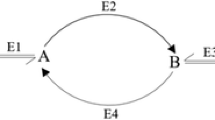Abstract
The functional coupling of contractile activity to metabolic processes in skeletal, cardiac and smooth muscle has been extensively examined in the intact cell through the advent of 31P-NMR spectroscopy. The near-equilibrium formulation for creatine kinase (CK) has been used for the calculation of ADPfree and ATP chemical potential in many of these studies. However, control of the bulk cytoplasmic PCr/Cr ratio by the ATP/ADP ratio through CK implies that the ATP/ADP ratio is the same in all loci within the cell. Alternatively the cytoplasmic fraction of ATP and ADP must be so large that other 'compartments' do not influence the physicochemical properties of the bulk cytoplasm. By feeding creatine analogs to rodents, it is possible to test whether these synthetic analogs and the endogenous substrates obey simple rules of enzyme kinetics and equilibration. Two important concepts can be tested: (1) Are phosphorus metabolises fully visible to in vivo 31 P-NMR measurements? (2) Does CK equilibrate with its substrates in the cytosol? It will be shown that in spite of localized enzymatic activity and microcompartments in the cell (such as mitochondria), creatine kinase equilibrates with its substrates in fast and slow skeletal muscles at rest. Therefore, the physicochemical properties of the cytosol are best described as freely mixing with respect to the bioenergetically important metabolites (PCr, ATP and phospho-analog) and fully quantifiable by 31 P-NMR spectroscopy. It follows that only a narrow range of intercellular heterogeneity with respect to chemical potential is acceptable if bioenergetic processes (e.g. CK fluxes or regulation of oxidative phosphorylation) are to be meaningfully interpreted in a rigorous biochemical framework. (Mol Cell Biochem 174: 23–28, 1997)
Similar content being viewed by others
References
Veech RL, Lawson JWR, Cornell NW, Krebs HA: Cytosolic Phosphorylation Potential. J Biol Chem 254: 6538–6547, 1979
Connett RJ: Analysis of metabolic control: new insights using scaled creatine kinase model. Am J Physiol 254: R949–R959, 1988
Meyer RA, Sweeney HL, Kushmerick MJ: A simple analysis of the' Phosphocreatine Shuttle'. Am J Physiol 246: C365–C377, 1984
Kushmerick MJ, Moerland TS, Wiseman RW: Mammalian skeletal muscle fibers distinguished by contents of phosphocreatine, ATP, and Pi. Proc Nat Acad Sci 89: 7521 –7525, 1992
Wallimann T, Wyss M, Brdiczka D, Nicolay K, Eppenberger M: Intracellular compartmentation, structure and function of creatine kinase isoenzymes in tissues with high and fluctuating energy demands: the 'phosphocreatine circuit' for cellular energy homeostasis. Biochem J 281: 21–40, 1992
Saks VA, Kuznetsov AV, Kuprlyanov W, Miceli MV, Jacobus WE: Creatine kinase of rat heart mitochondria: The demonstration of functional coupling to oxidative phosphorylation in an inner membranematrix preparation. J Biol Chem 260: 7757–7764, 1985
Wiseman RW, Kushmerick MJ: Creatine kinase equilibrium follows solution thermodynamics in skeletel muscle. J Biol Chem 270: 12428– 12438, 1995
Wiseman RW, Moerland TS, Chase PB, Stuppard R, Kushmerick MJ: High-performance liquid chromatographic assays for free and phosphorylated derivatives of the creatine analogues beta-guanidopropionic acid and 1-carboxymethyl-2-iminoimidazolidine (cyclocreatine). Anal Biochem 204: 383–389, 1992
Wiseman RW, Moerland TS, Kushmerick MJ: Biological applications for small solenoids: NMR spectroscopy of microliter volumes at high fields. NMR in Biomed 6: 153–156, 1993
Meyer RA, Brown TR, Krilowicz BL, Kushmerick MJ: Phosphagen and intracellular pH changes during contraction of creatine-depleted rat muscle. Am J Physiol 250: C264–C274, 1986
Humphrey SM, Garlick PB: NMR-visible ATP and Pi in normoxic and reperfused rat hearts: a quantitative study. Am J Physiol 260: H6– H12, 1991
Hutson SM, Berkich D, Williams GD, LaNoue KF, Briggs RW: 31P NMR visibility and characterization of rat liver mitochondrial matrix adenine nucleotides. Biochem 28: 4325–4332, 1989
Meyer RA: A linear model of muscle respiration explains monoexponential phosphocreatine changes. Am J Physiol 254: C548–C553, 1988
Wiseman RW, Kushmerick MJ: Myosin Isoform changes in skeletal muscles of mice treated with synthetic analogs of creatine. FASEB J 8: A10, 1994
Author information
Authors and Affiliations
Rights and permissions
About this article
Cite this article
Wiseman, R.W., Kushmerick, M.J. Phosphorus metabolite distribution in skeletal muscle: Quantitative bioenergetics using creatine analogs. Mol Cell Biochem 174, 23–28 (1997). https://doi.org/10.1023/A:1006843504179
Issue Date:
DOI: https://doi.org/10.1023/A:1006843504179




